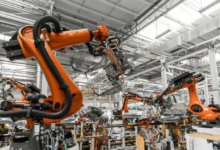Key Factors to Consider When Choosing a Pneumatic Lifting Device

Choosing the right pneumatic lifting device can make a significant difference in workplace efficiency, safety, and productivity. These devices are designed to lift, move, and position heavy loads using compressed air, offering a cleaner and more energy-efficient alternative to traditional lifting systems.
In this article, we’ll discuss the key factors to consider when selecting a pneumatic lifting device from load capacity and control precision to maintenance needs to help you find the best solution for your industrial or manufacturing applications.
What is a Pneumatic Lifting Device?
A pneumatic lifting device is a tool that helps lift and move objects using compressed air instead of manual effort or electricity. It’s made to handle materials safely and efficiently, especially heavy, fragile, or repetitive loads.
The device works through vacuum technology, which uses suction cups to grip and hold objects securely. Here’s how the process works:
- Vacuum Generation: Compressed air passes through a vacuum ejector, creating a suction force that forms a low-pressure area.
- Surface Contact: Suction cups, usually made of rubber or silicone, attach tightly to the object’s surface, forming an airtight seal.
- Lifting and Holding: The vacuum maintains strong suction, securely holding the object in place so it can be lifted or moved safely without slipping.
- Release: When air is reintroduced into the system, the pressure equalizes, breaking the vacuum seal and allowing the object to be released smoothly.
These devices are commonly used in manufacturing, construction, logistics, and electronics for efficient material handling. They help protect both the items being moved and the workers, while also improving efficiency and productivity.
Key Factors to Consider
When selecting a pneumatic lifting device, several important factors must be evaluated to ensure safe, efficient, and long-lasting operation. Each factor plays a role in performance, safety, and ease of use in different working environments.
- Load Capacity
Determine the maximum weight you need to lift. Pick a device rated 10–15% above your heaviest load to ensure safety and prevent overloading, which can cause damage or accidents.
- Application Environment
Consider where the device will be used:
- Cleanrooms, food, or pharmaceutical industries: Use stainless steel or food-grade materials.
- Dangerous areas with flammable gases or dust: Pneumatic devices are ideal since they don’t produce sparks or electrical risks.
- Ergonomics and Operator Comfort
A well-designed device reduces fatigue and prevents injuries. Look for adjustable handles, balanced weight, and easy-to-use controls to make operations more comfortable and efficient.
- Customization Options
Different materials and shapes require specific lifting tools to ensure a secure and efficient grip. Pneumatic lifting devices can be customized with special suction cups, grippers, or end-effectors to suit the object being handled.
For example, porous materials like wood allow air to pass through, so they need specially designed suction cups to maintain strong suction. Customizing the lifting tool ensures better grip, improved safety, and smoother performance, especially when handling irregular or delicate items.
- Safety Features
Ensure the device has overload protection, emergency stops, and fail-safe systems. It should also meet industry safety standards to prevent accidents and protect both operators and materials.
- Maintenance and Durability
Choose equipment that is durable and requires minimal maintenance. Pneumatic systems generally last longer due to fewer moving parts. Easy access to spare parts and following a maintenance schedule will reduce downtime and extend device life.
By carefully considering these factors, you can select a pneumatic lifting device that is safe, efficient, and reliable for your specific industrial needs.
See also: The Ultimate Showdown: Thermal Paste vs Thermal Pad – Which is Better?
Applications of Pneumatic Lifting Devices
Pneumatic lifting devices are tools used in many industries to handle materials safely, accurately, and efficiently. They reduce manual effort, improve productivity, and enhance workplace safety.
- Manufacturing
On assembly lines, these devices help lift and position parts precisely, reducing strain on workers. For example, pneumatic manipulator arms improve speed and accuracy in automotive assembly while keeping operations safe.
- Construction and Rerailing
On construction sites, pneumatic lifting devices safely raise heavy machinery and materials. Pneumatic lifting bags can lift large or uneven loads in tight spaces. They are also used in rerailing to lift derailed train cars smoothly and efficiently.
- Glass and Metal Handling
Handling fragile materials like glass or metal sheets requires care. Vacuum lifters with pneumatic suction cups grip items securely without causing scratches or damage. These devices are widely used in glass manufacturing, metal fabrication, and sheet handling.
- Electronics and Precision Industries
Delicate electronic components need precise handling. Pneumatic lifting devices provide controlled movement and suction, preventing damage and ensuring accurate placement of items like circuit boards or small parts.
- Warehousing and Logistics
In warehouses, pneumatic hoists and balancers make lifting and moving heavy packages easier. They reduce worker fatigue, speed up operations, and improve overall efficiency and safety.
Pneumatic lifting devices are versatile tools used in manufacturing, construction, rerailing, glass and metal handling, electronics, and warehousing. They make lifting faster, safer, and more precise, making them essential for modern industrial operations.
Cost and Energy Efficiency Considerations
Pneumatic lifting devices are energy-inefficient, converting only about 10–15% of electricity into usable lifting power. This means that most of the energy is lost when air is compressed and transported through the system.
Because of this low efficiency, the majority of the operating cost comes from the electricity used to run the air compressors, not from the lifting operation itself.
Key Factors Affecting Costs and Efficiency
- Air Pressure – Higher air pressure requires more energy from the compressor, which greatly increases electricity consumption and operating costs. Always set the pressure to the lowest level that still meets your needs.
- Leaks and Losses – Air leaks, long piping runs, and too many bends cause pressure drops and waste energy. Regular maintenance and an efficient piping layout help reduce these losses.
- Usage Patterns – Using equipment at higher pressure than necessary or for tasks that occur rarely increases energy costs. Match air usage to actual demand and consider alternative systems for light or infrequent tasks.
Tips to Improve Efficiency
- Set the right air pressure – Adjust the air pressure to meet actual operating needs to avoid wasting energy.
- Repair leaks quickly – Regularly check for and fix leaks to prevent air loss and reduce energy costs.
- Improve piping design – Simplify the piping layout and minimize bends or long runs to reduce pressure drops.
- Reuse exhaust air or waste heat – Capture and reuse exhaust air or heat from compressors to save energy.
- Choose efficient systems – For light or occasional lifting, use electric or hydraulic systems instead of compressed air to increase efficiency.
Pneumatic lifting devices are flexible and powerful, but they can use a lot of energy and be costly if not managed properly. To save energy and reduce costs, properly design the system, prevent leaks, and match the device to the workload.






